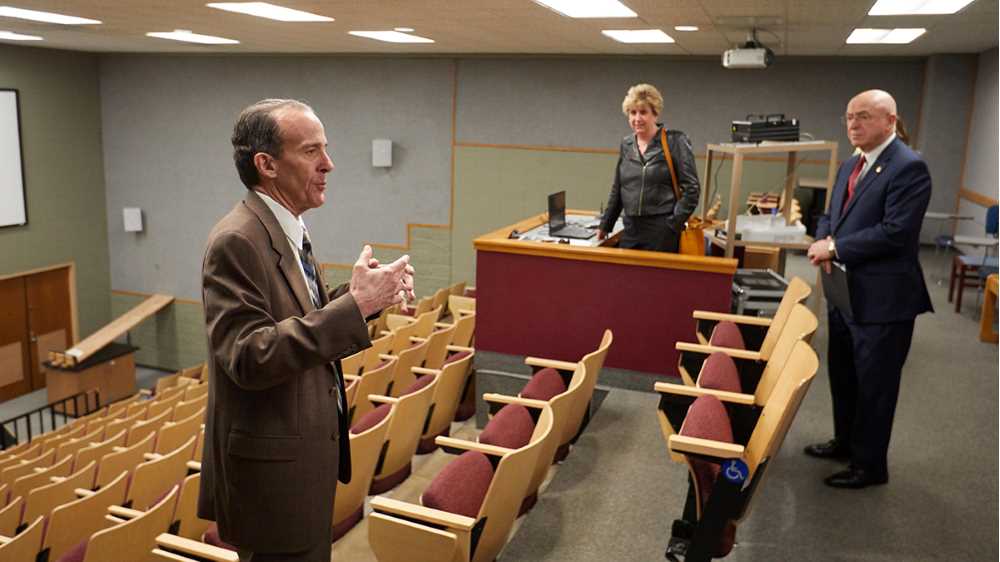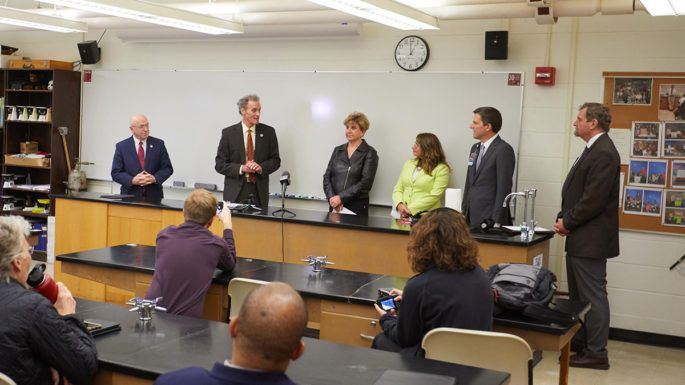Posted 3:25 p.m. Tuesday, May 21, 2019

UW System President Ray Cross, area leaders join in endorsing Phase II of science center.
UW System President Ray Cross, area leaders join in endorsing Phase II of science center
University of Wisconsin System President Ray Cross, UW-La Crosse Chancellor Joe Gow and area business leaders urged public and state support for Phase II of the Prairie Springs Science Center on Tuesday, May 21, after touring the aging facilities the building would replace.
Constructing the second phase of the science center would help UWL produce more graduates in high-need STEM programs, including in-demand health careers and the state’s high-growth occupations in biochemistry and biophysics.
“Wisconsin needs to attract and retain talent, and the UW System offers a solution,” Cross said. “Growing Wisconsin’s talent pipeline requires a reinvestment in classrooms to train and develop graduates in high-demand science and math programs.”
Gow said the second phase of the science center is critical to the region’s economic competitiveness.
“This is about investing in the potential of our students, our faculty, our community and our state,” Gow said. “Our partners in the business community know how important the science center is to the area’s growth.”
Vicki Markussen, executive director of the La Crosse Area Chamber of Commerce, says UWL is an economic driver in the region surrounding La Crosse that needs to remain globally competitive. “The Prairie Springs Science Center will create local jobs not only through its construction, but for years to come through the students it attracts and, long-term the faculty it will house,” says Markussen. “Our economy needs more students pursuing science, technology, engineering and math (STEM) degrees. Having a state-of-the-art facility in which to spark interest and innovation is important to connecting students with our employers.”
The new building is also key for continued growth and success of area health organizations. “Mayo Clinic Health System is supportive of education and research in this region, which is the foundation of science-based careers such as those in healthcare and many others,” says Mayo Health Systems Vice President for the Southwestern Region Dr. Paul Mueller. “Careers in the health sciences are essential for the improvement of the well-being of our community, as we work together to seek innovative solutions to the challenges facing us, such as the opioid crisis and access to high-quality care. Investing in science infrastructure at UWL will help prepare tomorrow’s healthcare workforce.”

The UW System is seeking $83 million in bonding for the project. Gov. Tony Evers included that amount in his 2019-21 spending plan.
The new facility would complete construction of the science center to house new instructional and research labs, a greenhouse observatory, and student-centered, technology-rich classrooms and learning spaces. It would foster increased student and faculty collaboration and additional enrollment in science, mathematics and health programs.
Phase I of the science center was completed for $82 million in 2018. The new building would enhance education for more than 2,000 students seeking careers in health professions needing access to modern, state-of-the-art technology.
The center would replace Cowley Hall, which is 54 years old, structurally incapable of being renovated and uses electrical, plumbing and life safety systems that are beyond their life spans.
“If we are to attract and retain talented students and faculty we need labs and classrooms that facilitate teaching, learning and research in the 21st Century,” Cross said. “The UW System and UW-La Crosse are invaluable state and community assets that can meet Wisconsin’s needs and move us forward.”
UWL’s College of Science and Health has a proven track record of success in its departments. Students have greater than 98 percent pass rate on professional certification exams. Annually, more than 175 undergraduates engage in faculty-mentored research supported, in part, by over $1 million in external grant funding, which results in more than 80 peer-reviewed publications. And, 40 percent of the college’s students continue on to graduate science programs or professional medical degree programs after graduation.
